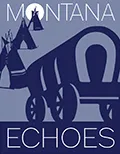Coulson (Boothill) Cemetery Park
Billings, Montana
Listen to Audio
Coulson Cemetery Park, commonly referred to as Boothill Cemetery, is a two-acre, hilltop parcel owned by the City of Billings, located at the intersection of Aronson Avenue and Swords Lane near MetraPark.
The park, as well as the town Coulson, the predecessor of present-day Billings, draws its name from the Coulson Packet Line, which operated steamboats from St. Louis on the Missouri River and the lower stretches of the Yellowstone River until competition from the railroad displaced it in the mid-1800s.
The exact number and names of the individuals buried in Coulson Cemetery Park are a matter of conjecture. The consensus of those who have studied the site puts the number between 130 and 150. The majority were interred during Coulson’s short-lived heyday, from 1877 to 1882. In many cases, the deceased were interred using their assumed, versus given, names. Many died violent deaths; others were not identified.
Ballad of Boot Hill
Fifty graves on the brow of the hill,
Aglow in the blazing western sun;
Fifty men who fought with a will—
And died with their boots on, every one.
Houston Daily Post, Nov. 1906
Where “Bad Men” Sleep Their Last Sleep.
Cemetery near Billings, Mont., where fifty graves tell of as many violent deaths.
Minneapolis Journal, October 1906.
The “Boots” Graveyard
With the advent of Coulson came the establishment of the “Boots” graveyard. There is a popular opinion to the effect that this ancient cemetery derived its pecurliar name from the fact that every one buried therein died with his boots on. An old citizen informs the writer that this idea is erroneous. Two or three of the interred of the graves on the lonely hill were suicides and several others died from accidental injuries. The writer has counted 34 graves in the cemetery. It is located on a bleak hill on the ridge that divdes Alkali Creek from the Yellowstone Valley and is about a mile north of the old town. It is possible that many more were buried there and their graves are unmarked. The first victim of the “killing” spirit that prevailed to a greater or less extent in those days was buried in the “Boots” graveyard in March 1882. He was a waiter in a restaurant and while watching a big gambling game he made some untimely remark which reflected on the honesty of the dealer. The gambler stabbed him to death and fled and was never captured.
The Anaconda Standard, Sunday, December 17, 1905.









